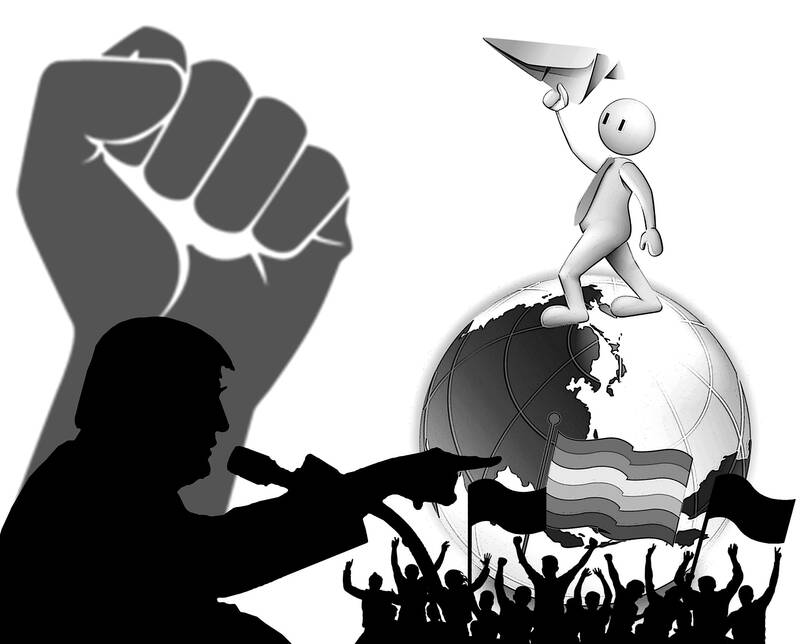It is easy to conclude that the “woke” revolution met its “Waterloo” on Tuesday last week. The Republicans ran the most “unwoke” man in the US for the presidency and were amply rewarded for it.
The top reason why swing voters eventually supported US president-elect Donald Trump over US Vice President Kamala Harris was culture, followed by inflation, a post-election analysis by the polling company Blueprint discovered. Trump lieutenants, such as US vice president-elect JD Vance and his nominee for secretary of state, US Senator Marco Rubio, regard the destruction of the “woke regime” as a top priority.
The Democratic establishment is already blaming the woke wing of the party for the loss. James Carville, former US president Bill Clinton’s campaign director, has blamed the loss squarely on the party’s failure to distance itself from “woke era” politics. Joe Scarborough, a former Republican congressman and now host of MSNBC’s Morning Joe, has blamed “white elitists” and their obsession with symbolic politics.

Illustration: Constance Chou
“What on earth is Latinx? No Latino person uses the word Latinx, but people spouted this, because they felt they had to,” The Economist editor-in-chief Zanny Minton Beddoes said.
Europeans are taking careful note of this. Middle-of-the-road conservatives such as the new leader of the UK’s Tories, Kemi Badenoch, would no doubt intensify their war on wokeism while more hard-right figures such as Italian Prime Minister Georgia Meloni would go into overdrive. Center-left parties would flee from cultural issues even more rapidly than they would flee from photo opportunities with Harris: British Prime Minister Keir Starmer has already declared that the UK would not be paying reparations for slavery to former colonies.
However, was Tuesday last week really Waterloo or is it merely a skirmish in a drawn-out campaign? Is a single election enough to put an end to a cultural movement? Or is it an opportunity for reassessment and regrouping? There are three strong reasons for thinking that the “Great Awokening” would survive the setback.
The first is that the “wokery” has reshaped — and in some cases captured — a broad range of powerful institutions, such as academia, mainstream media, public corporations and the public sector. The essence of wokery is a focus on the role of race (and by extension gender, sexual orientation and colonialism) in the division of power and economic gains, and a belief that past injustices were so searing that they justify reverse discrimination and the policing of speech. (Conservatives would replace the word “focus” with “obsession” and worry that guilt blinds the left to the West’s many achievements).
A plethora of indicators (such as the decline of media mentions of phrases such as “white privilege”) suggest that we have passed “peak woke,” The Economist said. However, this is to mistake effervescence for essence; the essence is that major institutions have been comprehensively reordered over the past decade or more to give a much higher profile to woke concerns.
Universities are central institutions, because they control entry into most well-paying jobs. However, it is hard to see how Trump’s election would change the fact that, particularly in the US’ most elite temples of learning, wokery has tenure.
Academics have shifted significantly to the left in recent years: Only 1 percent of academics call themselves conservative, a survey by student newspaper the Harvard Crimson found. Universities have also institutionalized progressivism by the creation of specialized subjects (black studies or women’s studies) and by the creation of a growing class of academic administrators who tend to be even more progressive than academics.
Corporations cannot treat public opinion with the disdain of tenured academics. Many companies such as Walt Disney Co and Anheuser-Busch InBev SA/NV’s Budweiser have retreated from public statements after being badly burned in the culture wars. Bloomberg journalist John Authers said that corporate commitment to environmental, social and governance goals had been waning long before Trump’s election, in part because of poor returns. However, these tactical retreats should not distract our attention from the fact that the corporate landscape has been changed. Almost all big companies have ironclad commitments to diversity, equality and inclusion. About 48 percent of S&P 500 Index companies tied bosses’ remuneration to diversity targets last year and the share of job advertisements that mention the word “diversity” continues to grow, pay consultancy Farient Advisors said. Management consultancies have imbibed so deeply of the wokery potion that, McKinsey & Co in its Web site features an article on “how leaders can tap the power of vulnerability.”
The second is that wokery thrives in opposition. What better proof is there that Americans need to be re-educated than the fact that they re-elected Trump to the White House? What better feeling is there than the feeling that you are part of a righteous minority? The New York Times took a significant step to the progressive left during Trump’s first administration in part because the most uncompromisingly anti-Trump articles did so well. The Guardian, which made a point of assuring its staff on the night of the election that it had therapists available, has already promised to “redouble our efforts to hold the president-elect and those who surround him to account.”
The most important reason is generational: Younger people are on average much more woke than older ones. Polls show that younger voters are more likely to vote for Democrats than Republicans by significant margins, perhaps not a surprising verdict. They also show that they endorse hardline progressive positions. Harvard’s Harris poll showed that nearly half of US “Zoomers” support Hamas over Israel. A Skeptic Research Center survey found that a similar share believe “the Israeli government advocates for white supremacy” (the share of older people who agree with such propositions is in the low, single digits). This enthusiasm for hardline positions is not confined to the US: British 18-to-25-year-olds split evenly on whether Harry Potter author JK Rowling (who thinks that a biological male is not a woman) should be dropped by her publisher, while fewer than 5 percent of those older than 50 do, Buckingham University sociologist Eric Kaufmann said.
“Progressive illiberalism may be less fashionable in the boardrooms of 2024 than it was in 2020,” Kaufmann said, “but its writ is likely to run through them in 2044.”
We should expect a few strategic retreats in response to Trump’s re-election. More universities would declare “institutional neutrality.” CEOs would memory hole their more hysterical comments about “intersectionality.” “Latinx” would be consigned, unmourned, to a lexicographical graveyard. However, the woke resistance would be as loud as ever in Harvard Yard and Sproul Plaza. When it comes to reshaping culture, a single victory, however famous, is not the end of the war.
Adrian Wooldridge is the global business columnist for Bloomberg Opinion. A former writer at The Economist, he is author of The Aristocracy of Talent: How Meritocracy Made the Modern World.

“History does not repeat itself, but it rhymes” (attributed to Mark Twain). The USSR was the international bully during the Cold War as it sought to make the world safe for Soviet-style Communism. China is now the global bully as it applies economic power and invests in Mao’s (毛澤東) magic weapons (the People’s Liberation Army [PLA], the United Front Work Department, and the Chinese Communist Party [CCP]) to achieve world domination. Freedom-loving countries must respond to the People’s Republic of China (PRC), especially in the Indo-Pacific (IP), as resolutely as they did against the USSR. In 1954, the US and its allies
Mainland Affairs Council Deputy Minister Shen You-chung (沈有忠) on Thursday last week urged democratic nations to boycott China’s military parade on Wednesday next week. The parade, a grand display of Beijing’s military hardware, is meant to commemorate the 80th anniversary of Japan’s surrender in World War II. While China has invited world leaders to attend, many have declined. A Kyodo News report on Sunday said that Japan has asked European and Asian leaders who have yet to respond to the invitation to refrain from attending. Tokyo is seeking to prevent Beijing from spreading its distorted interpretation of wartime history, the report
Indian Prime Minister Narendra Modi arrived in China yesterday, where he is to attend a summit of the Shanghai Cooperation Organization (SCO) with Chinese President Xi Jinping (習近平) and Russian President Vladimir Putin today. As this coincides with the 50 percent US tariff levied on Indian products, some Western news media have suggested that Modi is moving away from the US, and into the arms of China and Russia. Taiwan-Asia Exchange Foundation fellow Sana Hashmi in a Taipei Times article published yesterday titled “Myths around Modi’s China visit” said that those analyses have misrepresented India’s strategic calculations, and attempted to view
When Chinese President Xi Jinping (習近平) stood in front of the Potala Palace in Lhasa on Thursday last week, flanked by Chinese flags, synchronized schoolchildren and armed Chinese People’s Liberation Army (PLA) troops, he was not just celebrating the 60th anniversary of the establishment of the “Tibet Autonomous Region,” he was making a calculated declaration: Tibet is China. It always has been. Case closed. Except it has not. The case remains wide open — not just in the hearts of Tibetans, but in history records. For decades, Beijing has insisted that Tibet has “always been part of China.” It is a phrase